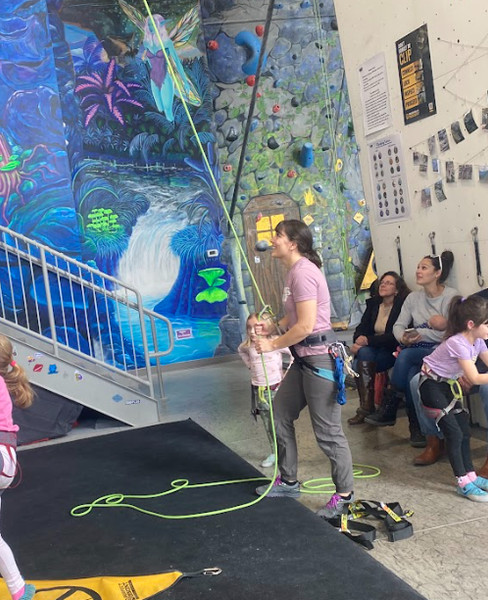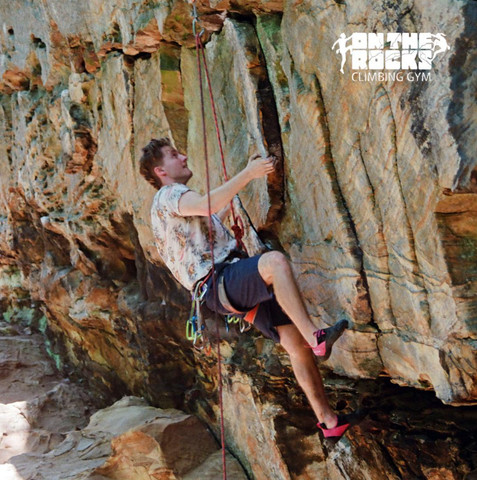Rock climbing stands out as a uniquely rewarding sport, blending the exhilaration of physical exertion with the strategic depth of mental problem-solving. It’s a dance with gravity, a test of personal limits, and an incredible way to connect with nature or push your boundaries in the gym. However, at the heart of safe and enjoyable climbing is a critical skill: Belay Rock Climbing. More than just a technique, belaying is the essential system that secures a climber’s progress, embodying trust and responsibility between climbing partners. Mastering belaying is fundamental for anyone venturing onto the vertical world, whether scaling indoor walls or tackling outdoor rock faces.
 Rock climber being belayed indoors for safety
Rock climber being belayed indoors for safety
Understanding the Fundamentals of Belaying
At its core, belaying is a sophisticated rope management technique designed to protect a climber from falls. This method is indispensable for ensuring safety in various climbing environments, from the controlled setting of indoor climbing gyms to the unpredictable nature of outdoor crags. The belayer, positioned on the ground or at an anchor point, is the climber’s lifeline. Equipped with a specialized belay device attached to their harness, the belayer controls the climbing rope, meticulously managing its tension. These devices, ranging from simple, reliable tubular designs to more advanced assisted-braking models, utilize friction to amplify the belayer’s holding power, making it possible to securely catch and lower a climber.
The belayer’s role is multifaceted and demanding. Their primary responsibility is to be ready to catch a fall instantaneously. Should a climber lose their grip or footing, the belayer’s swift action of applying braking force to the rope through the belay device is crucial. By effectively locking off the rope, they can arrest the fall, minimizing the distance and preventing serious injury.
Beyond fall protection, belaying also provides crucial support for climbers to rest and strategize. When a climber needs to pause, recover, or assess the route ahead, the belayer can take in slack on the rope and secure it. This action allows the climber to hang comfortably, conserving energy and planning their next moves without the constant fear of falling.
Furthermore, belaying is essential for controlled descent. Once a climber reaches the top of a route or needs to come down, the belayer is responsible for safely lowering them back to the ground. By gradually releasing the rope through the belay device in a controlled manner, the belayer regulates the speed of descent, ensuring a smooth and safe return to the base. Effective belay rock climbing is a dynamic and engaged process, demanding constant vigilance, rapid reactions, and a thorough understanding of both the equipment and the techniques involved. It’s a fundamental skill that underpins all safe and successful rock climbing endeavors.
 Lead climber being belayed outdoors on a rock face
Lead climber being belayed outdoors on a rock face
Types of Belaying Techniques
Within rock climbing, two primary belaying techniques are employed, each tailored to different climbing styles and environments: top-rope belaying and lead belaying. These methods vary significantly in their application and the level of climber and belayer expertise required.
Top-Rope Belaying: Beginner-Friendly Safety
Top-rope belaying is frequently utilized in indoor climbing gyms and for outdoor climbs where the rope is pre-anchored at the summit. Often considered the most accessible and safest introduction to belaying, it’s particularly suited for beginners and for practicing techniques. In top-rope setups, the rope runs from the belayer, up to an anchor point at the top of the climb, and then down to the climber. This configuration ensures that the climber is always supported from above, significantly reducing fall distances to minimal lengths, typically just a few inches.
The role of the belayer in top-rope belaying is to manage rope slack as the climber ascends. The belayer continuously takes in rope to maintain a taut line, ready to arrest any fall instantly. This requires consistent attention and responsive adjustments, ensuring there’s enough tension to provide immediate fall protection without hindering the climber’s upward movement. Top-rope belaying is an excellent method for learning fundamental climbing movements and building confidence in a secure environment.
Lead Belaying: For Advanced Climbs
Lead belaying is a more advanced technique predominantly used in outdoor climbing and on challenging indoor routes where there is no pre-set top rope. In lead climbing, the climber ascends with the rope originating from the belayer below, progressively clipping the rope into protection points (quickdraws or trad gear) placed along the route. This approach allows climbers to tackle routes taller than a single rope length, as the rope is dynamically secured as they climb higher.
In lead belaying, the belayer’s crucial role is to feed out rope slack smoothly as the climber ascends and clips. The belayer must provide enough rope for the climber to move freely and make clips, but not so much slack that a fall would be dangerously long. This demands a high degree of anticipation and quick reflexes. The belayer needs to predict the climber’s movements, understand clipping procedures, and adjust rope management accordingly to minimize potential fall distance while still allowing for fluid climbing. Lead belaying requires more experience and coordination between climber and belayer, as it involves managing dynamic forces and a greater potential fall distance compared to top-roping.
Both top-rope and lead belaying demand a comprehensive understanding of belaying principles, robust communication between partners, and a steadfast commitment to safety protocols. Regardless of the type, the ultimate goal of belay rock climbing remains constant: to create a safe and enjoyable climbing experience through diligent rope management and mutual trust.
The Step-by-Step Belaying Process
Belaying is a structured process that begins well before the climber leaves the ground. It starts with a series of critical safety checks to confirm that all components are correctly set up and functioning. This includes verifying that both the climber’s and belayer’s harnesses are properly buckled and double-backed, the rope is correctly threaded through the belay device, and the locking carabiner is securely closed and locked. These pre-climb checks are non-negotiable and form the foundation of safe belay rock climbing practices.
Following the equipment checks, clear and agreed-upon communication signals must be established between the climber and belayer. These signals, often a combination of verbal commands and rope tugs, are essential for seamless coordination and safety during the climb. For example, a climber typically says “climbing” to signal their intention to start ascending, and the belayer responds with “climb on” to indicate they are ready to belay. Other common signals include “take” (climber wants slack taken in), “slack” (climber needs more rope), and “falling” (though hopefully never needed!). Consistent and understood communication is vital for preventing misunderstandings and ensuring a safe climbing partnership.
Throughout the entire climb, the belayer must maintain unwavering vigilance. Their focus should be exclusively on the climber, constantly observing their movements, and anticipating their needs. The belayer must be prepared at all times to take in slack, feed out rope, or lock off the belay device instantly if a fall occurs. This continuous attentiveness demands a high level of concentration and the ability to react swiftly and appropriately to any situation that may arise on the wall. Effective belay rock climbing hinges on this constant, dedicated focus from the belayer.
Avoiding Common Belaying Mistakes
Even seasoned climbers and belayers are susceptible to errors. Recognizing and avoiding common belaying mistakes is crucial for maintaining safety and preventing accidents. One frequent error is failure to properly lock the carabiner. An unlocked carabiner can lead to the belay device detaching from the harness under load, a potentially catastrophic mistake. Always double-check that the carabiner is fully locked before climbing commences and periodically throughout the session.
Another common mistake involves improper slack management. Providing too much slack in the system can result in a climber experiencing a longer, more jarring fall than necessary. Conversely, providing too little slack can impede the climber’s movement, potentially pulling them off balance or making it difficult to clip in lead climbing situations. Finding the right balance of slack requires practice and attentive belaying.
Lapses in focus and distractions are also significant contributors to belaying errors. Belaying demands constant concentration, and any distraction, such as conversations, phones, or simply losing focus, can lead to delayed reactions or missed signals. Belaying should always be treated as a primary task, requiring undivided attention for the duration of the climb.
The most effective way to prevent these and other belaying errors is through proper training and consistent practice. Learning from certified climbing instructors is highly recommended to gain a solid foundation in safe belaying techniques. Regular practice in a controlled environment, such as a climbing gym, helps reinforce correct procedures and build muscle memory, making safe belaying a more automatic and reliable skill.
Belaying Etiquette: Building Trust and Communication
Belaying is not solely about technical proficiency; it’s equally about fostering respect, clear communication, and profound trust between climbing partners. The climber-belayer relationship is fundamentally a partnership, where each person’s actions directly impact the other’s safety and experience. Mutual trust and respect are the cornerstones of effective and enjoyable belay rock climbing.
Clear and consistent communication is paramount in belaying etiquette. Before starting to climb, both partners should explicitly agree on the verbal signals and any other communication methods they will use. This ensures that both climber and belayer are on the same page and can effectively convey their needs and intentions throughout the climb. Miscommunication can lead to confusion, delays, and potentially unsafe situations.
Respect for each other’s roles and capabilities is another essential aspect of belaying etiquette. The belayer should respect the climber’s pace, skill level, and comfort zone, providing encouragement and support without pressure. Conversely, the climber should respect the belayer’s responsibility and avoid placing them in unnecessary or unpredictable situations. Open communication about comfort levels, route choices, and any concerns helps build a respectful and supportive climbing partnership. Belaying is a shared activity that thrives on mutual consideration and understanding.
Learning to Belay: Classes and Professional Training
For individuals new to rock climbing or those looking to refine their belaying skills, enrolling in belay classes is an invaluable step. These classes, commonly offered by climbing gyms and outdoor centers, provide structured, hands-on training in the fundamentals of safe and effective belaying techniques.
In a typical belay class, participants will learn about the different types of belaying, including top-rope and lead belaying, and gain practical experience using various belay devices. Instruction covers the correct procedures for setting up the belay system, conducting safety checks, utilizing communication signals, and mastering the physical skills required for taking in and paying out slack, catching falls, and smoothly lowering climbers.
Crucially, belay classes place a strong emphasis on safety protocols and risk management. Instructors highlight common belaying errors and teach participants how to avoid them, as well as the proper methods for conducting pre-climb safety checks and responding to unexpected situations. Participants also get ample opportunity to practice belaying under the watchful eye of experienced instructors, receiving immediate feedback and corrections to develop good habits from the outset.
Most climbing gyms and outdoor recreation facilities offer belay rock climbing classes as part of their introductory programs. These classes are typically led by certified climbing instructors who possess extensive knowledge and experience in climbing safety and instruction. Whether you are a complete beginner eager to start climbing safely or an experienced climber aiming to enhance your belaying proficiency, a belay class is a highly recommended investment in your climbing journey, ensuring you and your partners can enjoy climbing adventures with confidence and safety.
 People learning belay techniques in a rock climbing class
People learning belay techniques in a rock climbing class
Frequently Asked Questions About Belay Rock Climbing
What is the primary purpose of belaying in rock climbing?
Belaying in rock climbing is primarily for safety. It’s a technique used to protect a climber from falling a long distance. The belayer manages the rope to catch the climber if they slip or lose their grip, ensuring a safer ascent and descent.
What are the essential pieces of equipment for belaying?
The essential belaying equipment includes a climbing harness for both the climber and belayer, a belay device, a locking carabiner to connect the belay device to the belayer’s harness, and a dynamic climbing rope. Each piece of equipment plays a critical role in the belay system’s safety and functionality.
Could you explain the key differences between lead and top-rope belaying?
In top-rope belaying, the rope is already anchored at the top, providing a direct safety line from above, ideal for beginners and controlled environments. Lead belaying is more advanced, where the climber brings the rope up, clipping into protection points along the way; this requires more dynamic rope management from the belayer and is used for more challenging climbs.
What are some of the most frequent mistakes to avoid when belaying?
Common belaying mistakes include not properly locking the carabiner, giving too much or too little slack, and losing concentration. These errors can be avoided with thorough training, diligent pre-climb checks, and maintaining focus throughout the climbing activity.
What are the basic principles of good belaying etiquette?
Good belaying etiquette centers on clear and consistent communication between the climber and belayer, mutual respect for each other’s roles and capabilities, and a shared commitment to safety. Trust and attentiveness are key components of respectful and effective belaying partnerships.
Is it advisable to learn belaying without professional instruction?
While resources like books and videos can provide basic information, it is strongly discouraged to learn belaying solely on your own. Professional instruction from certified instructors is crucial for learning correct techniques, understanding safety nuances, and practicing in a controlled environment, ensuring a safe start to belay rock climbing.
Do most climbing gyms require a belay certification?
Yes, most indoor climbing gyms require individuals to pass a belay test or obtain a belay certification to ensure they have the necessary skills and knowledge to belay safely within their facilities. This is a standard safety measure to protect all climbers and maintain a safe climbing environment.
Conclusion
Belay rock climbing is the linchpin of safety and enjoyment in vertical adventures. It’s a skill that demands respect, continuous learning, and unwavering attention. Mastering belaying techniques, understanding the nuances of communication, and always prioritizing safety are paramount for anyone venturing into the world of climbing. With proper training, diligent practice, and a responsible approach, belaying transforms from a mere technique into a gateway for countless safe and exhilarating ascents. Embrace the learning process, commit to safety, and unlock the incredible experiences that belay rock climbing makes possible.
